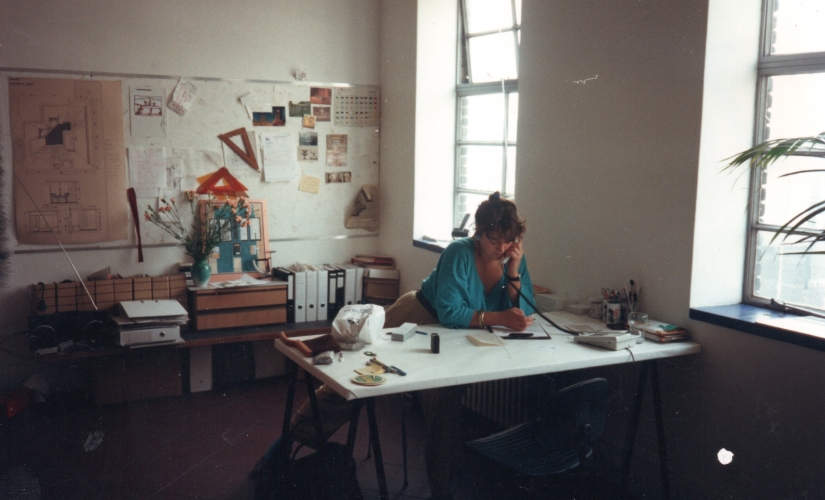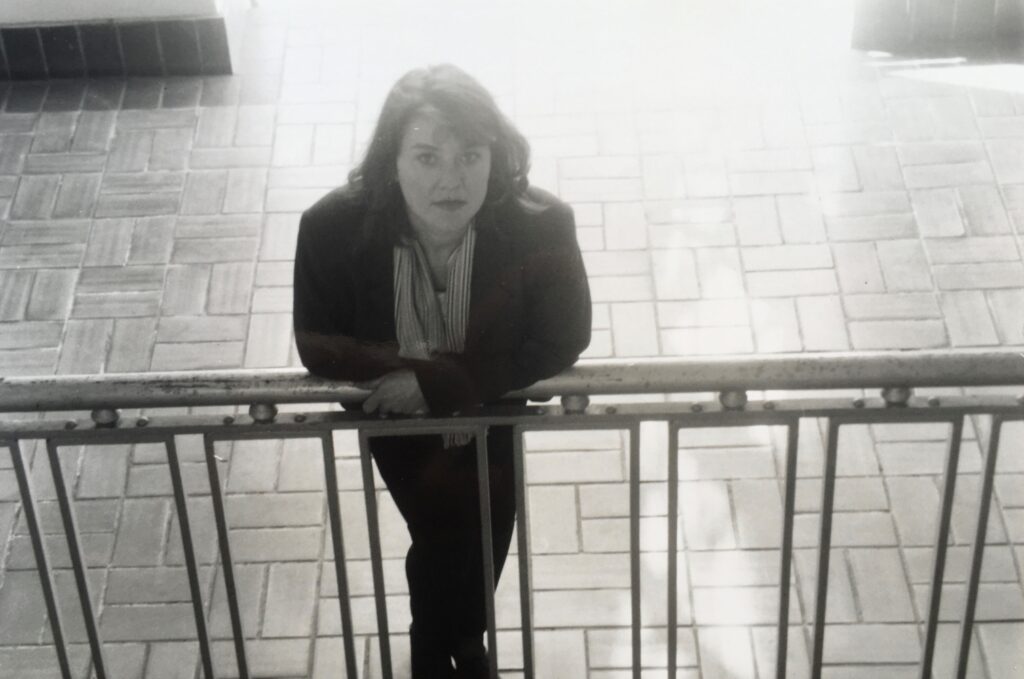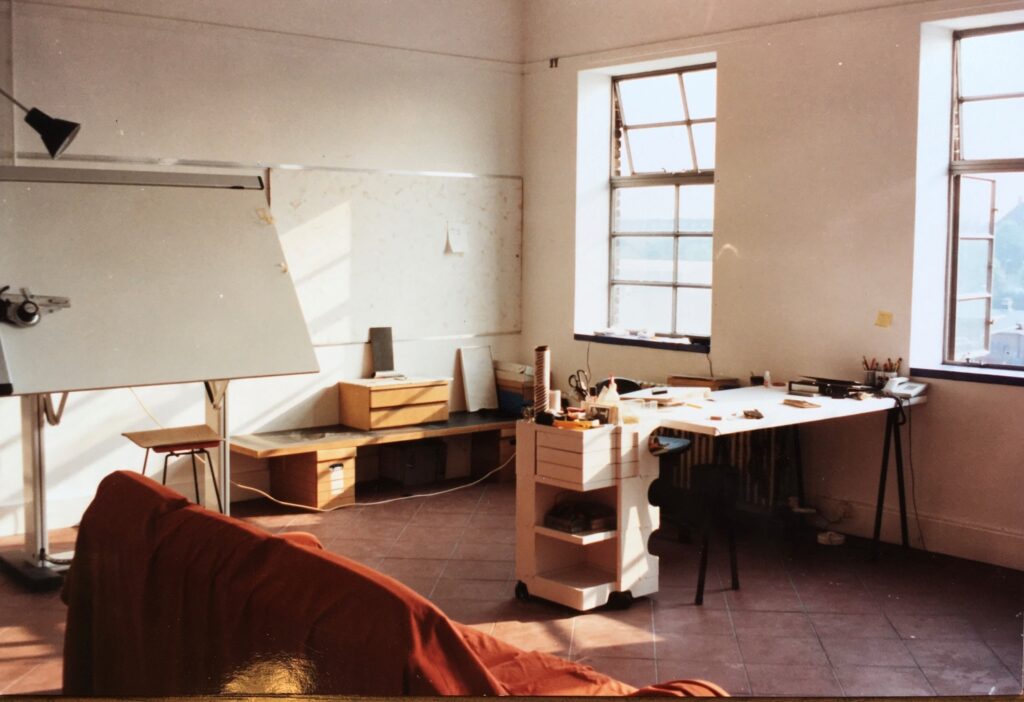
November 18, 2022
“I always entered in the scent of oranges.”
In the late 80s, Carla Boomkens was one of the tenants of the Centrale Markthal in Amsterdam. Specifically, she rented office space 123 on the third floor. I visited the Markthal with her to reminisce and revisit her former workspace. It was a visit filled with nostalgia because the place is still so beautiful, but it was not Carla's own choice to leave the Markthal. "In de late jaren 80 was Carla Boomkens een van de huurders van de Centrale Markthal in Amsterdam. Ze huurde specifiek kantoorruimte 123 op de derde verdieping. Ik bezocht samen met haar de Markthal om herinneringen op te halen en haar voormalige werkplek opnieuw te zien. Het werd een bezoek met enige weemoed, omdat de plek nog steeds zo mooi is, maar het was niet Carla's eigen keuze om de Markthal te verlaten."
I meet Carla outside the Markthal: an energetic woman eager to go inside. Everything we see evokes a memory, the paternoster lifts she used to jump into, the restrooms, the hallways, and of course, the market square. In the old photos she brought along, she is depicted as a young woman leaning over the balustrade and working in her office space. She recounts how she visited one of the other tenants whom she knew from the Rietveld Academy and was immediately enchanted by the building. At that time, she had just started her career as an independent designer/interior architect and knew right away that she wanted to work in the Markthal. Having done an internship in Milan, she recognized the Mediterranean influence in the Markthal. The colors and scents of the traded goods, the long corridors with windows. “The Markthal was the ideal workplace for her.”
De geur van sinaasappels
’In the early morning, there was bustling activity on the premises and inside the Markthal. The market vendors displayed their goods in the hall for the traders. From the balustrades, she saw an array of colors and smelled the scent of oranges. Around 10 o’clock, the tranquility returned, and the Markthal was deserted.
Lars van Vianen also recognizes the early activity on the premises and the calmness in the Markthal. Lars is the current occupant of office space 123 and warmly welcomes us into his office today. The space has been rearranged now, with the lowered ceiling removed, but the view is still spectacular. Carla has brought old photos to show how the space looked back then. The building was slated for demolition, and she tells us that the landlord had removed the central heating boiler to discourage tenants from staying in their spaces. She continued to work there for one winter with two butane heaters and blankets, but it was challenging to work almost alone in such a large building, and in the early 90s, she eventually left with a heavy heart. To this day, she believes she didn’t have to leave at all, as there were already creative people there during her time, just like now. She admits to being “a little jealous of the current occupants.”
A place where you could experiment
Carla tells us about her father, who was born in 1921 and lived on Nassaukade. She knows his stories of playing on the site when it was being filled before the construction of the Markthal. Lars also regularly encounters people who are familiar with the Centrale Markthal from the past because they, for example, worked there. Younger people are aware of the place but have no idea what happens on the premises. The place has an air of mystery. When an event is organized in the Markthal, you can see the lighting shining through the glass roof.
“That mysterious place allowed me,” Carla says, “to work extremely hard, with an unobstructed view, undisturbed. It was a place where I could experiment, explore through making.” During that time, she was taking violin lessons and could practice unlimitedly without bothering anyone. Carla tells us that she once organized a party in her space, placing candles in the window sills, creating an incredible atmosphere. There was no one bothered by it because the Markthal was empty in the evenings.’
Een juweel op het terrein
Als ze een nachtje doorwerkte dan hoorde ze ‘s ochtends de karretjes van de handelaren rijden. Het voelde als een impressionistisch zuidelijk schilderij. De kleuren, de groenen, het oranje en het wit van de knoflook, beeldschoon. Op het plein in de Markthal kwam ze niet, daar had ze niets te zoeken, maar ze had het mooiste uitzicht vanaf de derde verdieping, waar ze de verte in kon kijken en op ideeën kon komen. Een omgeving doet er echt toe. Dat neemt ze ook mee in haar eigen ruimtelijke ontwerpen, in ritme, de vormen, de detaillering en maatvoering. Het ritme, de details van de Markthal waren voor haar inspiratie om zelf ook een goed ontwerp te maken.
De Markthal voelde ook als een veilige plek, het terrein is beveiligd, er waren portiers en beveiligers. Het terrein is wat haar betreft weinig veranderd. De gebouwen rond de centrale hal hebben weinig identiteit: daardoor valt de Markthal extra op, als een juweel op het terrein.
As we conclude our appointment, we gaze at the Markthal, which is covered in scaffolding. There is a sense of nostalgia in the air, and Carla has enjoyed our visit. She shares that she has considered renting a space in the Markthal again but hasn’t made up her mind yet. She would contemplate it if it would promote the mentoring of young visual talents; they too should be able to experience this remarkable place. Carla would love to see the Markthal become a hub for the Rietveld Academy or perhaps the University of Amsterdam. That would once again foster the cross-pollination among different disciplines that she finds so valuable. Who knows what the future holds.
Text: Carolien Nijkamp
Photos: Carla Boomkens


